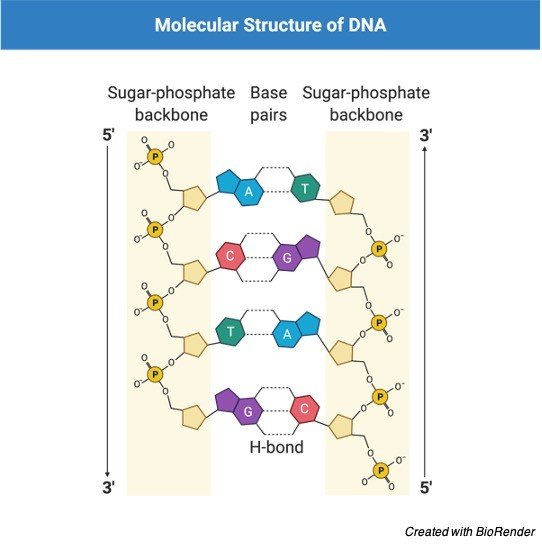What is DNA Helix?
Generally, the functioning of DNA wholly depends upon its structure. DNA Helix here describes about the structure of DNA. Deoxy ribo nucleic acid is known as DNA.
It is one of the principal information in the macromolecule of the cell. Where DNA double helices are made up of stiff polymers which range in a length of about 10nm.
Thus, the double helix of a DNA is first observed by Watson and Crick. This molecular model of a DNA consisting of double helix can be compared with the spiraling stair case of a twisting ladder.

This double helical structure consists of two chains of intertwined sugar-phosphate having the base pairs in a flattened manner which forms a step like structure of the helix.
This structure of DNA provides a firm basis for understanding the basic version of DNA during the process of cell division and also in maintaining the characteristics of a genome.
This model helps us to understand how genes and chromosomes work together in duplicating themselves.
This three-dimensional helical structure also acts as a good icon in many scientific discussions which is because of its amazing structure and its elegant information about the molecule of DNA.
Its double helical form is one of the reasons why all organisms are connected to each other by having the same structure for sharing the information in the form of heredity.
Role of DNA Helix in DNA Replication
The double helical shape of the DNA, which is in the form of a spring has rugs which join the two fragments of the DNA.
They are formed up by two terminal bases. They consist of four base pairs namely adenine, thymine, guanine and cytosine.
Here the double helices separate themselves in one place between two strands and it is further detached.
By separating each other one strand attains a complementary bases until each of the strand forms a copy of new double helical structure.
Here the complementary strands are always replaced with the original one because adenine always pairs up with thymine and guanine always pairs up with cytosine.
The process of replicating of double helix is generally referred to as template replication. Here one strand stands as a mold for each other and it should be added in the steps during the duplication of DNA.
The duplication process is not activated suddenly it needs some catalytic activity to promote the process of replication.
Why DNA is Called as the Genetic Material?
During the early 19’s it is considered that all living organisms are made up of cells and the activities of each individual depends up on the growth and activity of the cells.
Then later, the introduction of microscopes and other improvements in scientific fields let us to know about the chromosomes and the knowledge of chromosomes such that it carries hereditary material are later came in to an understanding.
Later by many researches it is found that chromosomes are made up of half DNA and the other half is made up other necessary proteins. Further Watson and crick developed the model for the structure of DNA and the feature of its structure with double helices and their replication processes.
In the structure of model proposed by them it is said that each strand of the DNA serves as a template for synthesizing the complementary strand.
Subsequent research by Watson and crick found out the model of replication and then they proposed that DNA carries the genetic information to all the cells and also for next generations.
Double DNA Helix Model
Scientific models are very much useful in explaining the real objects or systems which helps us to predict the behavior or function of the specific object. Where as the model of Double helical DNA is used to visualize the primary concept and function of its properties.
In DNA Helix, covalent bonds are present between the linear strands of a DNA which helps in maintaining a strong bond between the base pairs and the hydrogen bonds between them.

The hydrogen bond occurs between two strands of the Double helical structure and it also involves base at one strand combined with the base of another strand.
These hydrogen bonds are individually weak and on combining, they are strong. By studying the cross pattern of genetics, it confirms by highlighting the helical structure of DNA.
DNA Helix and Its Role in DNA Fuctions
We know that the DNA is made up of base pairs along with its sugar phosphate back bone. Here the two strands of DNA help in processing the mechanism of copying the molecules.
While separating each strand provides a template for creating the other strand; then further while separating the double helixes two daughter molecules are produced.
The base pairs that are present in each strand activates the digital code, which transmits the information for functioning of life.
This double helix only helps in storing and processing of information in our cells and also an important role in replication, duplications and other technologies and functions that is functioning in our body.
There is no doubt that two great scientists Watson and crick play a very important role in identifying the structure and function of DNA.
DNA Helix Citations
Share









